How do I find where Paul writes about preaching?
Hi Eddi
how can I find all verses where paul speaks about preaching?
I assume from your question you want places where Paul writes about preaching as opposed to when he is reported as speaking the word
If so, you can just search within the Pauline Epistles as per the second part of the screenshot below
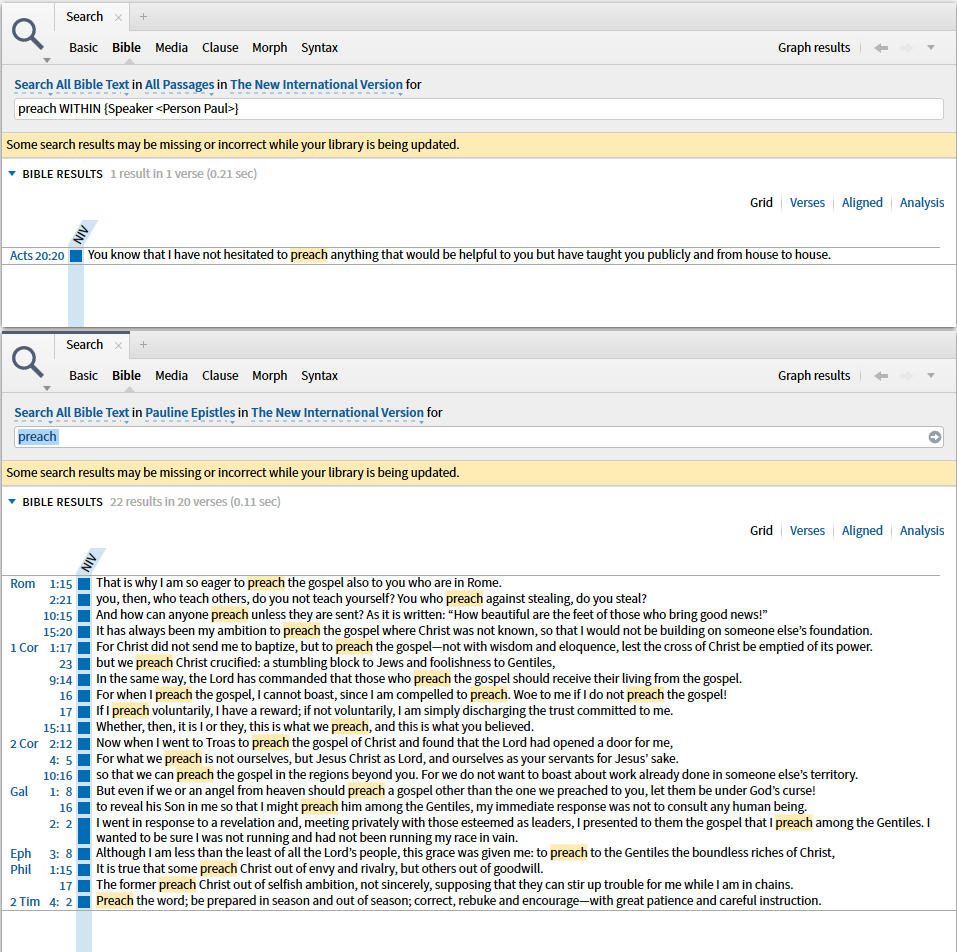
You can select this from the range dropdown as shown below
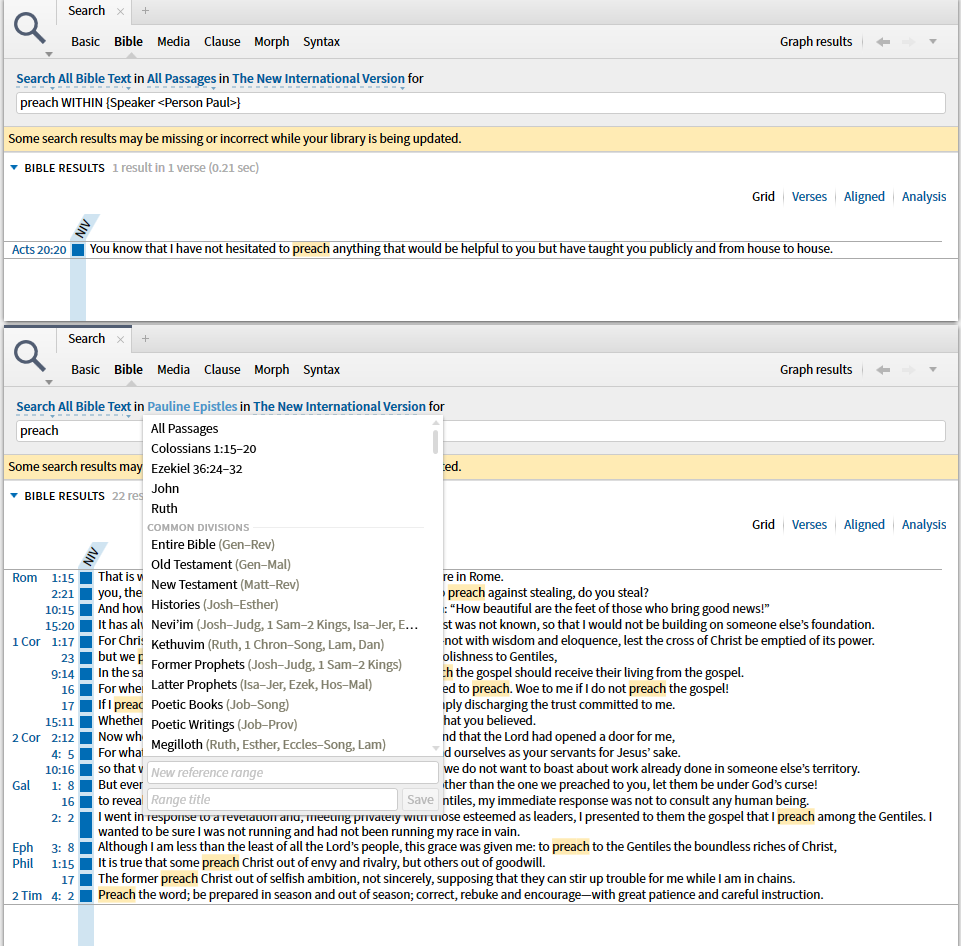
Does this help?
Graham
how can I find all verses where paul speaks about preaching?
Graham offered some incredible advice for accomplishing what you are looking for. I would like to piggy back off what he said and offer search syntax that will go a bit further. One of the primary Greek roots that is translated as "preach" is the Greek lemma κηρυσσω. This Greek word has both verbal and noun forms. To find all of these, run a root search of the lemma along with the english word "preach." This will find places where the word "preach" appears, but is not represented by the lemma κηρυσσω, but also places where synonymous words like "proclaim" and "message" appear that use the Greek word.

Last thing, make sure that you have "Match All Word Forms" turned on when running this search.
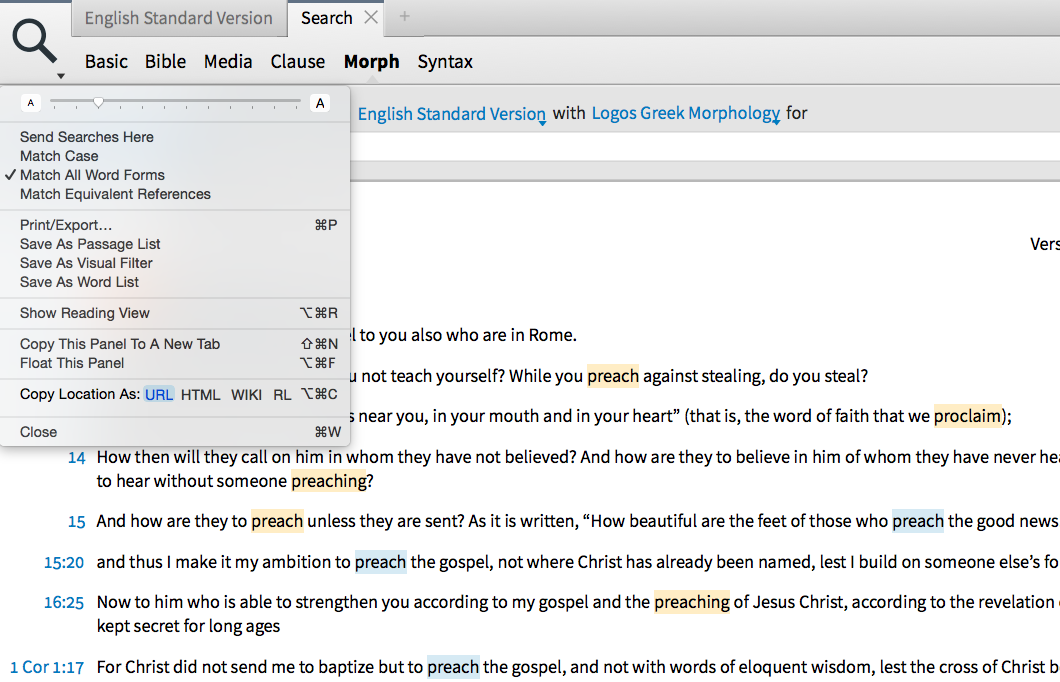
Thank you Graham and Mike! That helps me a lot, also for further searching.
Sense searching can help here as well. When you do your first simple search (e.g. on the word "preach", it's worth switching to analysis search and grouping by "sense". That way you can see which senses the word can have.
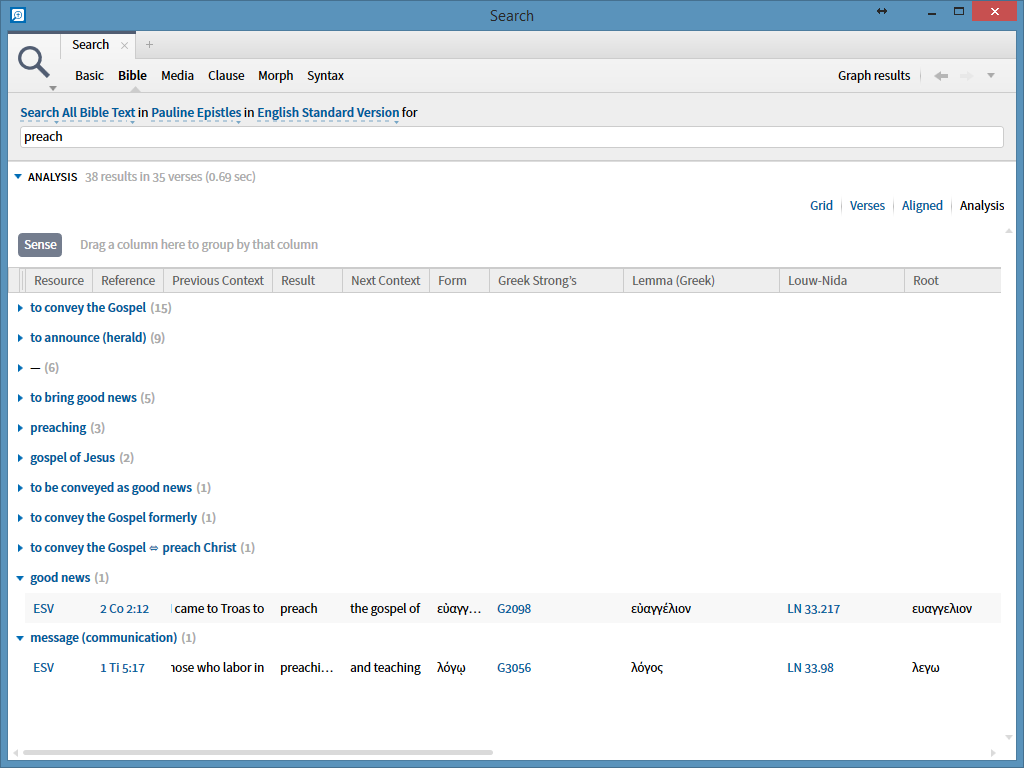
You can then expand your search by adding the most relevant senses into your search criteria. Like this:
<Sense = to convey the Gospel>, <Sense = to announce (herald)>, <Sense = to bring good news>, <Sense = preaching>, <Sense = to be conveyed as good news>, <Sense = to convey the Gospel formerly>, <Sense = to convey the Gospel ⇔ preach Christ>
In addition to what's already been found by preach, root:κηρυσσω, that adds Romans 10:8, 1 Corinthians 2:4, 2 Corinthians 4:5, 11:5, Galatians 2:2, Philemon 1:14, 17, 1 Thessalonians 2:2, 3:6, 2 Timothy 4:17.
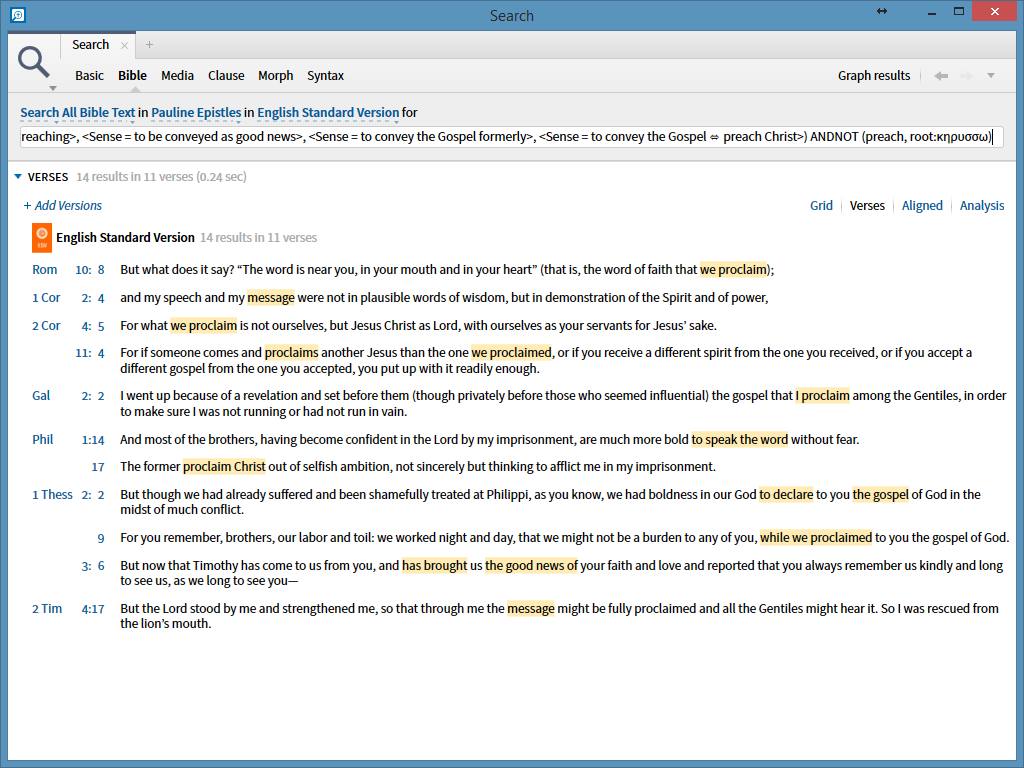
You could also use a similar method to discover the Louw-Nida senses that are returned by a simple search result, and add them to the mix. The most relevant LouwNida senses are 33.215, 33.256–33.261. That adds in several more possibilities (which a few false positives):

Looking at the analysis search for these results suggested that we missed some senses earlier, particularly "to be heralded". You could add that into your search too (in this case that would add any additional search results, but for other searches, it might, so it's good to get into the habit).
What resources contain the London Baptist Confession of 1689?
There's a PB here on the forums: https://community.logos.com/forums/p/45121/336086.aspx. There are copies in Logos here:
There's also a few copies of the 1688 Philadelphia Confession, which is almost (but not quite) identical:
Finally, there's a interesting list of the differences between the 1689 confession and the Westminster Confession here:
There is a modern English version of the London Baptist Confession in this collection:
How do I advance through my resource by highlights?
Could someone please tell me how to advance through one of my resources by the highlighting I have added?
Ensure "Annotation" is selected in the locator bar and then use the up / down arrows to the right of it

or do an inline search for highlights and it will just show those in the resource

What is the explanation for apparently incorrect clause search results?
If you run a Clause Search for subject-lemma:אֱלֹהִים verb-morph:V????P (i.e. a search for clauses where the subject of the clause is e/Elohim and the verb is in plural), there are a large number of hits where אֱלֹהִים is not in any way a subject in the phrase, not even in a broad sense of being included in a prepositional phrase which modifies the subject. In fact, oftentimes אֱלֹהִים is the object within the clause.
Examples of false hits are:
Judg 20:2
1 Sam 8:8
2 Kings 17:7
2 Chr 11:16; 36:16
And there are more false hits than these…
I wonder if these errors (supposing they are errors - please let me know if I'm misinterpreting these results) are indicative of broader problems regarding the classification of subjects of clauses (or of other types of classification).

In Judges 20:2, the subject (as analyzed by Andersen and Forbes, shown above) is discontiguous. The lemma אֱלֹהִים occurs in the gap, not being part of the subject, but it is inside the span covered by the subject. That probably explains the error.
I'll see if I can get it fixed...
I looked at some more of the passages you mentioned:
The first few look OK to me.
In 1 Sam 8:8, אֱלֹהִ֣ים appears inside the subject of the clause וַיַּעַבְד֖וּ אֱלֹהִ֣ים אֲחֵרִ֑ים ("served other gods")

2 Kings 17:7 is similar.
In 2 Chr 11:16 the subject of a clause is מִ כֹּל֙ שִׁבְטֵ֣י יִשְׂרָאֵ֔ל הַ נֹּֽתְנִים֙ אֶת־לְבָבָ֔ ם לְ בַקֵּ֕שׁ אֶת־יְהוָ֖ה אֱלֹהֵ֣י יִשְׂרָאֵ֑ל which again meets your search criteria.
2 Chr 36:16 does seem incorrect, again caused by a syntax graph with crossing lines.
How do I create a list of all the OT quotes or allusions in the NT?
If you pick up THIS resource or THIS collection, you’ll most certainly get what you’re asking for.
If you are a Logos Now subscriber you could use the Reference option in the Concordance Tool

Graham
The Faithlife group OT Quotes in NT has a variety of documents giving the information - just extract the psalms.
Is there a way to get a list of all NT quotes or allusions from the Psalms?
Scott,
I wanted to offer a slightly different method.
There are two resources that I believe are in every base package that will help you with this. These are Old Testament Quotes in the New Testament by David Philipps and Old Testament Quotations and Allusions in the New Testament by David Jones. If you want strictly direct quotes, you want to use the former. if you want both quotes and allusions, use the latter.
Open a new search panel and set you search type to Basic. Then set the search parameters to "Search All Text in Old Testament Quotes in the New Testament." Then type "psalms" into the search bar and select the option for the biblical book in the drop down menu.

If you sort your search results "By Resource," it will list the hits by book in canonical order and give you a frequency on the right hand side. We can quickly see that Hebrews quotes Psalms the most, followed closely by Paul in Romans.

Lastly, you can open the resource to one of the results to view which NT verse(s) references it. You can also change your resource navigation to scroll by "Search Result." This will allow you to move through each hit.

You can do this same process for the resource Old Testament Quotations and Allusions in the New Testament. Hope this helps!
How do I create a blank workspace on which to create a new layout?
I'm sure this is covered somewhere but I can't seem to find it with anything I'm searching on. What I'd like to figure out how to create a layout from scratch. I'd like to start with a clean slate/layout.. . . Is there a simple way to clear the screen so I can accomplish this? Thank you and Lord bless!
Entering the command "close all" in the command box should do this
Shortcut keys:
- Mac - Opt-Cmd-W
- Windows - Ctrl-Shift-W
Does this give you what you need?
How do I turn the verse numbers back on?
You need to look on the visual filters menu (the three dots). There you will find all sorts of options for viewing the Bible text, including whether or not you want verses and chapter numbers:

Still resembles a wall of text
Do you mean that the line spacing is too close? Look in the Program Settings (found under the Tools menu) for this:

Can I combine my highlighted note documents?
It can be done but you need to move the highlights on at a time.
I have just created a short video to demonstrate it - available at http://screencast.com/t/1UcSqMMA
At the moment all my pallets are choosing "pallet specific note document" (thanks for actually letting me know where you can change that, never would have found it by chance).
One of the improvements in Logos 6.4 was the ability to use "resource-specific" notes files

From the release notes:
Highlighting
Added the option to save Highlights in Resource-specific notes files. This allows you to view all highlights on a particular resource in one Note, regardless of style used.
- This can be enabled individually for any palette from the options menu on the right side of the palette header, under “Save in:”.
- To save highlights using the old method, select “Palette-specific notes file”.
This could be a good option for highlights you create moving forwards. You can set the same setting (globally) on the iPad
How do I use a clause search to find everywhere God is the subject of the verb chapetz?
Larry,
Thanks for the question. There is a lot here, so I will walk it through step-by-step.
So I type subject:God verb-lemma:chapetz (using the Hebrew that pops up) and get two occurrences (Psa 35:27 and Mic 7:18).
The reason for receiving only two results is that you selected the instance where the Hebrew Lemma is the adjectival form of the Hebrew root. If you would have instead selected the first option in the drop down, this would have found the 30+ instances of the verbal form of the root. See image below for both search results.

Instead of running the search for "verb-lemma:חפץ.1" run it instead for "verb-root:חפץ.1." This will find all of the instances, both verbal and adjectival.

It omits Psalm 135:6 where the Lord does whatever he pleases (which is the text of study).
My best guess a the reason this is omitted is two-fold. 1) Andersen-Forbes identify this clause as part of the Direct Object of the verbal idea "to do" in their syntax analysis. 2) the person of God from the referent database is not tagged on this verbal idea.


It is my opinion that we should put this under review to receive tagging. We need to at least have the person:God attached to the verbal idea in this clause. I think this was a good find on your part.
I hope this helps to explain a bit further what is going on.
How do I check whether your documents are synced to the web?
There have been many past reports about sync issues and often it's hard to determine whether a sync problem (if there is one) lies with the Mobile or Desktop app.
To help find out where the issue might be here's what you can do. Open a web browser to http://documents.logos.com and sign in using your Faithlife account. Once signed in you can see all of your synced documents.
If the documents shown at http://documents.logos.com match your Desktop app but not your Mobile app, there might be a Mobile sync issue (or a network problem). If your documents don't match on Desktop, it's likely a Desktop sync issue.
Here's a screenshot of the Documents currently available at http://documents.logos.com :
